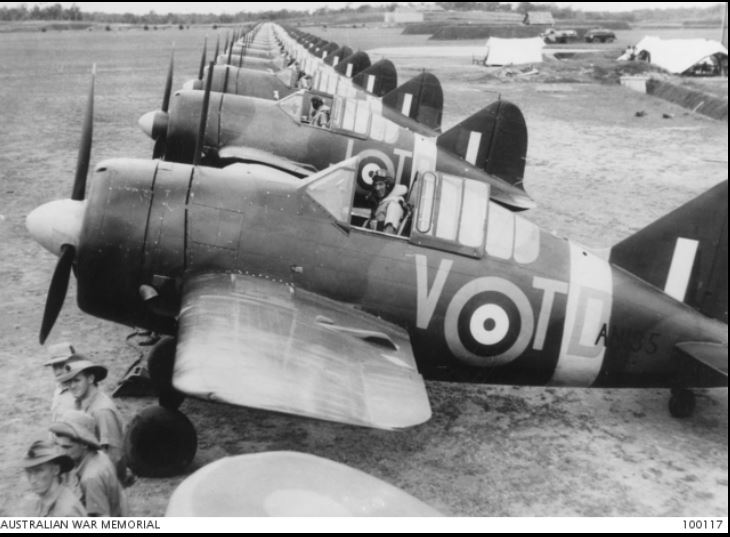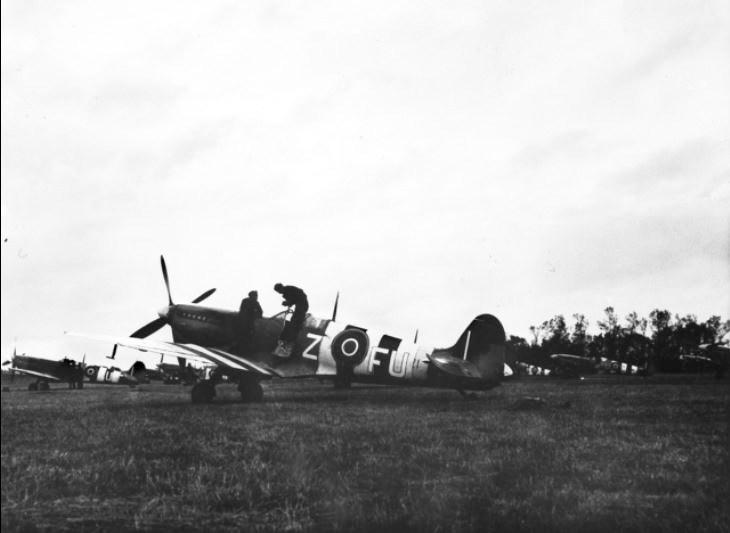No. 453 Squadron RAAF
From Our Contribution
Contents
[hide]Brief History
No. 453 Squadron was formed at Bankstown, New South Wales in May 1941. In mid July, the men embarked on the SS Marella and SS Sibajak for Singapore witht he first section arriving there on 15 Aug 1941. By the end of the month the Squadron had been equipped with Brewster Buffalo fighters and commenced training before being declared operational on 19 Nov 1941.
With the advent of war with japan, Singapore was raided by the Japanese Air Force on 8 Dec 1941. 453 Squadron were not involved, but on 10 December it was ordered to a area 50 miles east of Kuantan. When the fighters arrived, two unidentified aircraft were seen flying north; the Buffalos had arrived too late to prevent the sinking of HMS Repulse' and HMS Prince of Wales by Japanese torpedo bombers. Two days later, the Squadron was ordered north to the airfield at Ipoh to assist 21 Squadron and enroute the Squadron claimed its first blood. Alter refueling at Butterworth, two aircraft sighted enemy aircraft bombing Penang and attacked, claiming the destruction of five enemy aircraft. They then successfully ground strafed enemy troops north of Alor Star. Shortly after, another group of 453 Squadron aircraft refueled at Butterworth and were engaged by a large force of
enemy aircraft which was raiding the area. In this combat the unit suffered its first battle casualty in return for one claimed Japanese fighter.
Buffalos of 453 Squadron were based at Ipoh from 19 December, ground strafing and defending the airstrip against heavy Japanese raids. Lacking in spares, and with its ground crew largely still located at Sembawang, the Squadron's serviceable aircraft declined to three. This had increased to five on 19 December when, due to pressure from Japanese ground forces, the Squadron was withdrawn to Singapore. In battles on 22 December the Squadron lost three aircraft and and another four damaged, for three enemy a1rcraft confirmed destroyed and possibly another five. Two pilots were killed and two wounded.
The hard-pressed ground crew restored the crash-landed aircraft and by 23 December the strength of the Squadron had risen to seven. These
aircraft were flown back to Sembawang, from where they undertook patrols and reconnaissance flights from Singapore. On 17 January, Sembawang was raided and three enemy f1ghters were downed near Malacca. Two days later another four enemy aircraft were shot down. However, by the end of January 1942 the Japanese controlled the Malay Peninsula, and 453 Squadron remained as the sole fighter defence of Singapore. By 5 February Sembawang was untenable, due to constant shelling from the mainland, so all flyable aircraft were evacuated to Tengah, where they again came under enemy shell fire. The survivors took off for Kallang from where the four survivors, escorted by a Hudson, flew to Palembang in Sumatra. Here two aircraft were destroyed by high level bombing. On 6 Feb 1942 the remaining Squadron members were evacuated to Batavia, Java on HMS Danae and on SS City of Canterbury.
A detachment remained on Singapore Island destroying facilities, before boarding a small Norwegian ship for passage to Java. Now without aircraft,
453 Squadron personnel departed from Java on 22 February 1942, aboard SS Orcades, arriving at Adelaide, South Australia via Columbo on 15 Mar 1942.
The second 'life' of 453 Squadron commenced on 18 June 1942, when the Squadron was reformed at RAF Station Drem, about 35 miles from Edinburgh. It commenced flying Spitfires on 26 Jun 1942, and by the end of July they were ready for action. However, there was little enemy activity over Scotland and 453 Squadron undertook training, convoy patrols and pursuit of the occasional enemy incurs1on. At the end of September, the Squadron deployed to RAF Station Hornchurch, from where it flew 1ts first operation over occupied territory on 2 October. This was a sweep over Ostend, Ypres and Dunkirk, followed by several more such missions before the Squadron met any enemy opposition. On 30 October seven Spitfires intercepted a large enemy bomber formation headed for Canterbury. The Squadron moved to Southend in December.
The German Air Force's assault on England had abated, and the constant patrols over Southern England and over convoys seldom brought contact with the enemy. The moved back to Hornchurch late in March 1943, and on 11 Mar 1943 Squadron Leader Ratten was promoted to the ra1nk of Wing Commander and appointed to command the Hornchurch Fighter Wing. He was the first Australian to be appo1nted to command a wing an F1ghter Command. The Squadron moved again in June, to lbsley at the end of June before again moving, this time to Perranporth, in August 1943 and remained there until October before it moved to Detling in January 1944. The Squadron was escorting bombers over France and the Low Countries on an almost daily basis. These operations were made hazardous by anti-aircraft fire and German Air Force f1ghter interceptions.
On 8 October the Squadron claimed to have shot down five Messerschmitt BfllOs for the loss of one Spitfire. In mid-April 1944, 453 Squadron moved again to Ford and commenced dive bombing raids using 500-lb bombs; a task added to that of escorting Marauder, Mitchell, Liberator and Fortress bombers over France. Bridges, buildings, railways and road convoys in areas like Le Havre, Cambrai, Berck, Creil, Cap d'Autifer and Arramanenes were the targets, as the intensive operations of April and May were a precursor to the invasion of Normandy. On 6 Jun 1944, 453 Squadron flew 43 sorties providing tactical support for the troops landing on the Normandy beachhead. On 11 June, the Squadron operated from the beachhead itself where the Royal Engineers had constructed a landing ground. The Squadron had operated from advanced bases in the beachhead, until it moved to ALG B11 in France on 25 June 1944. Activity was hectic and by the end of July the Spitfires were credited with the destruction of an 18 truck German convoy. This operation was the first in which the Squadron Spitfires carried a bomb load of 1000 lbs. In a spectacular engagement during 9 July, 12 pilots of 453 Squadron attacked 40 Focke Wulf 190s and Bf109s over Lisieux, claiming four destroyed, one possibly destroyed and five damaged. Remarkably, not one of the Spitfires was hit and all returned safely to base, shooting up tanks and trucks on the way. The Squadron was re-equipped with Spitfire Mk IX aircraft, and celebrated on 24 July by shooting down two enemy aircraft. During July, 453 Squadron destroyed 12 enemy aircraft and accounted for over 90 enemy vehicles. With the break out form the beachhead, 453 Squadron was harassing the retreating German forces. Armed reconnaissance missions were flown over the Brussels-Antwerp area, but the period proved to be uneventful until, late in September, 453 Squadron again moved forward to a base near the Albert Canal, close to Antwerp. Here they were subject to shelling at night from German guns situated 3000 yards distant.
Before moving back to Coltishall on 30 September, the Squadron dstroye another five and damaged two German aircraft. The move was not popular with the Squadron. From there the aircraft were employed on patrols over the Low Countries, before moving to Matlask in mid-October. The landing of the first German V2 rocket on England on 8 September was the beginning of a new phase of operations for 453 Squadron. On 21 Nov 1944, four Spitfires, each carrying two 250-lb bombs, set out to attack a V2 launch site. Despite intense anti-aircraft fire, all the bombs fell on the target, and the area was strafed. Two hours later, another four 453 Squadron Spitfires attacked another rocket launch site, and another four dive bombed the rocket storage depot. The 'Rocket War' continued until 27 Mar 1945, when the last V2 landed on Orpington, Kent.
During February 1945, 453 Squadron successfully bombed the liquid oxygen factory at Loosduinen, near The Hague, thus limiting the quantity of this fuel available for use by the missiles. On 6 April the unit moved to Lympne, returning to its armed reconnaissance and bomber escort role. On 2 May 1945, 453 Squadron moved to its last wartime base, Hawkinge, from where it escorted Queen Wilhelmina of the Netherlands to the Continent. This marked the last wartime operation of 453 Squadron.
On 28 Aug 1945 the Squadron flew out from England for duty on the Continent. They arrived at Ostend on 29 August, then moved to Fassberg, where they remained for two weeks. On 16 September, the Spitfires landed at Gatow, Berlin, becoming the first British squadron to be stationed in the German capital. Little flying was undertaken, as Berlin was in the Russian Zone, and 453 Squadron deployed lo Wunstorf on 18 October. During October and November various Squadron members were posted back to England to wait repatriation to Australia. The Squadron still flew over Germany, but on 3 Jan 1946 news was received about the squadron's disbandment. The last weeks of the Squadron were marked by the death of the Commanding Officer, Squadron Leader Davidson, who was killed whc11 his aircraft crashed in Kent. No. 453 Squadron RAAF officially disbanded on 21 Jan 1946.
Twenty eight men died while posted to the Squadron.
Battle Honours
Individual Honours
- 11 x Distinguished Flying Cross
- 1 x Mentioned in Despatches
Notes
Content has come from Units of the Royal Australian Air Force - A Concise History - Volume 2 Fighter Units - Australian Government Publishing Service - 1995.

